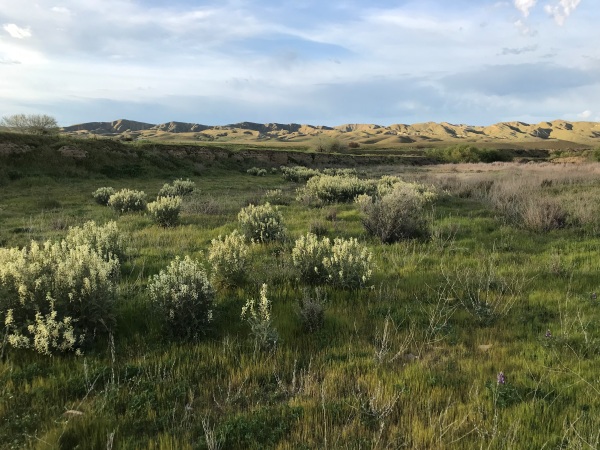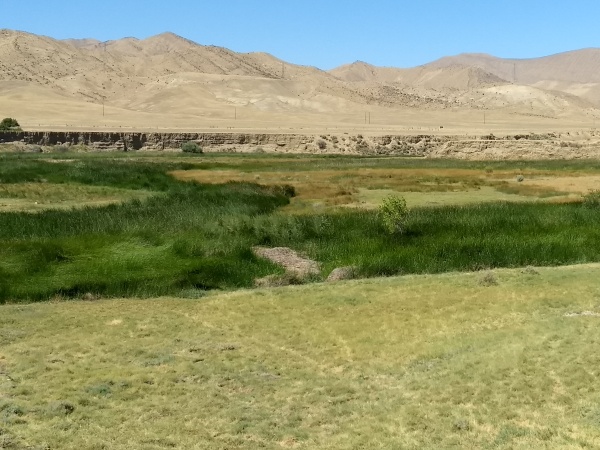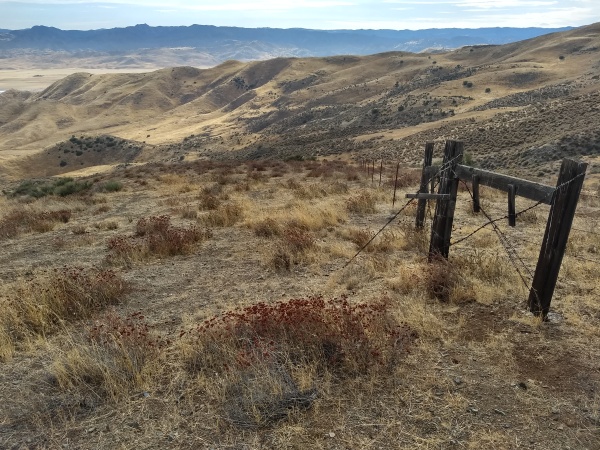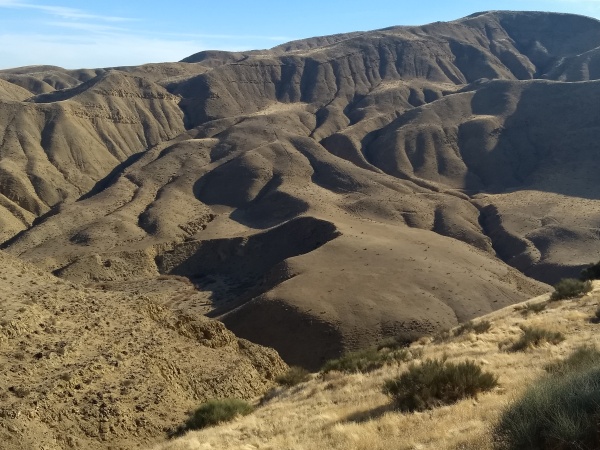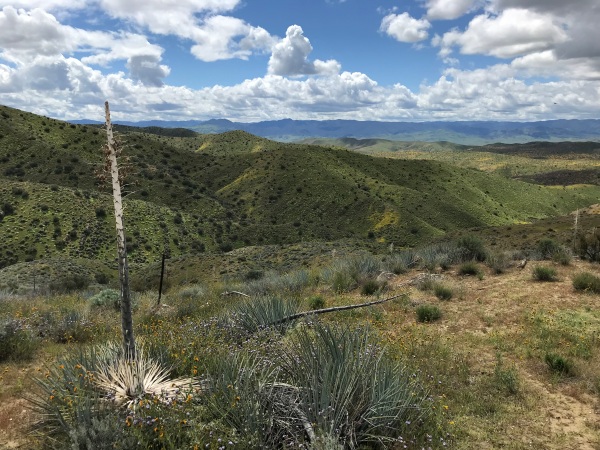


Area: 26,400 acres
Location: San Benito & Fresno Counties, California
Date Acquired: 2018
Acquisition Type: Center for Natural Lands Management owns and manages the preserve. We protect and manage listed species and their habitat on the preserve in perpetuity.
Key Habitats: Annual grassland, perennial grassland, desert scrub, blue oak woodland, juniper
Species of Special Interest to CNLM: blunt-nosed leopard lizard (Gambelia sila), California condor (Gymnogyps californianus), California tiger salamander (Ambystoma californiense), giant kangaroo rat (Dipodomys ingens), San Joaquin kit fox (Vulpes macrotis mutica), San Joaquin antelope squirrel (Ammospermophilus nelsoni), San Joaquin woolly-threads (Monolopia congdonii), tricolored blackbird (Agelaius tricolor) and vernal pool fairy shrimp (Branchinecta lynchi)
Introduction
The Panoche Valley Preserve permanently protects approximately 26,400 acres of annual grassland and desert scrub in Panoche Valley and surrounding foothills. The Preserve was created as partial mitigation for the Panoche Valley Solar project, initiated in December 2015, when the Panoche Valley Solar company granted CNLM a conservation easement over most of the Preserve lands. Protection of the Preserve finalized in August 2018, when full ownership and management responsibility of the entire Preserve was transferred to CNLM. Concurrently, CNLM transferred the conservation easement to another nonprofit conservation organization.
Conservation Significance
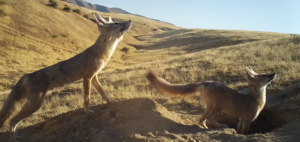 Because of its large size, isolated location, and topographic diversity, Panoche Valley Preserve is an important area for several threatened and endangered species as well as numerous species of concern. The Preserve, in combination with adjacent lands, is considered by US Fish and Wildlife Service as a core area of habitat necessary for the conservation and recovery of the San Joaquin kit fox, Nelson’s antelope squirrel, giant kangaroo rat, blunt-nosed leopard lizard, and San Joaquin wooly-threads. The region is unique in that it is found far to the north of the other two large core areas of habitat for these species (Carrizo Plain and western Kern County) and it is near the northern-most extent of many of these species’ ranges, thereby providing an important refuge that is buffered from impacts to other parts of the species’ range.
Because of its large size, isolated location, and topographic diversity, Panoche Valley Preserve is an important area for several threatened and endangered species as well as numerous species of concern. The Preserve, in combination with adjacent lands, is considered by US Fish and Wildlife Service as a core area of habitat necessary for the conservation and recovery of the San Joaquin kit fox, Nelson’s antelope squirrel, giant kangaroo rat, blunt-nosed leopard lizard, and San Joaquin wooly-threads. The region is unique in that it is found far to the north of the other two large core areas of habitat for these species (Carrizo Plain and western Kern County) and it is near the northern-most extent of many of these species’ ranges, thereby providing an important refuge that is buffered from impacts to other parts of the species’ range.
The Preserve also provides significant habitat for other listed species. For example, Panoche Creek Marsh is said to be one of the last places in California with large tricolored blackbird nesting colonies where both nesting substrate and foraging areas are completely natural habitat. In addition, although the Preserve represents only a small proportion of the remaining habitat for California tiger salamander, vernal pool fairy shrimp and California condor, protecting any such habitat is a benefit to these species.
Valley floor: Much of the Preserve (approximately 15,000 acres) consists of flat valley floor terrain within Panoche Valley and Little Panoche Valley, as well as gently rolling terrain on Silver Creek Ranch in the eastern portion of Panoche Valley. The deep loam soils and gentle terrain in these areas support annual grassland vegetation, and provide excellent habitat for giant kangaroo rats, San Joaquin kit fox, and many other valley floor plant and animal species. The valley floor areas also include several natural and artificial vernal pools, and several miles of riparian marsh along Panoche Creek, providing important nesting structure for tricolored blackbirds and other riparian species.
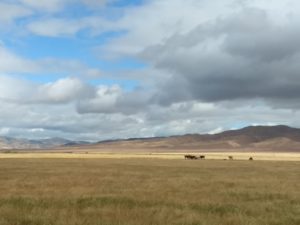 The valley floor of the Preserve supports high densities of giant kangaroo rats, a keystone species of the San Joaquin desert ecosystem. Giant kangaroo rats have a profound influence on the ecology of the Preserve by providing an important food source for various predators including San Joaquin kit foxes, burrowing owls, snakes and badgers. Their extensive burrow systems also provide shelter to numerous species including the blunt-nosed leopard lizard as well as other species of lizards, snakes and arthropods. They also modify their surroundings through their digging activities and vegetation clipping which provide benefits to other animals and to some plant species.
The valley floor of the Preserve supports high densities of giant kangaroo rats, a keystone species of the San Joaquin desert ecosystem. Giant kangaroo rats have a profound influence on the ecology of the Preserve by providing an important food source for various predators including San Joaquin kit foxes, burrowing owls, snakes and badgers. Their extensive burrow systems also provide shelter to numerous species including the blunt-nosed leopard lizard as well as other species of lizards, snakes and arthropods. They also modify their surroundings through their digging activities and vegetation clipping which provide benefits to other animals and to some plant species.
The valley floor grasslands support many species of birds, including golden eagle (Aquila chrysaetos), grasshopper sparrow (Ammodramus savannarum), short-eared owl (Asio flammeus), burrowing owl (Athene cunicularia), ferruginous hawk (Buteo regalis), Swainson’s hawk (Buteo swainsoni), mountain plover (Charadrius montanus), northern harrier (Circus cyaneus), white-tailed kite (Elanus leucurus), California condor (Gymnogyps californianus), loggerhead shrike (Lanius ludovicianus), and others. This diversity of bird species has led to the Panoche Valley being listed as one of Audubon’s globally significant Important Bird Areas.
In addition to the variety of animal species, the valley floor grasslands contain several sensitive plant species, including gypsum-loving larkspur (Delphinium gypsophilum), recurved larkspur (Delphinium recurvatum), and San Joaquin woolly-threads (Monolopia congdonii). Also, the Preserve contains most of the population of the rare Panoche navarretia (Navarretia panochensis), which was first described in 2018. Information on this plant found can be found in this CNLM news article, here.
Foothills: Other parts of the Preserve (approximately 11,400 acres) consist of rugged terrain in the foothills surrounding the Panoche Valley, including Panoche Hills, Griswold Hills, Las Aguilas Mountains, and Glaucophane Ridge. The rocky soils in these rugged areas support desert shrubland and juniper woodland, with smaller amounts of blue oak savanna and perennial grassland. These upland areas provide good habitat for the San Joaquin antelope squirrel, and other species such as golden eagle. These foothills include several hundred acres of serpentine soils, a harsh soil environment which provides habitat for several rare plant species such as chaparral ragwort (Senecio aphanactis) and serpentine leptosiphon (Leptosiphon ambiguous).
Our Work
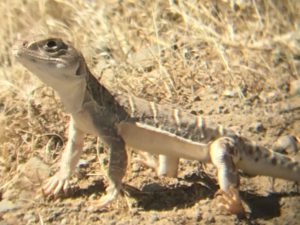 Management on the Preserve is guided by a management plan, a conservation easement, and other documents. Our work is focused on protecting sensitive species and their habitat which are characteristic of the San Joaquin Desert ecoregion—a region that, in recent decades, has experienced a dramatic conversion of natural grassland and shrubland vegetation to agricultural uses. Stewardship includes monitoring, stewardship of important plant communities, researching the ecology of target species, and maintenance of grazing infrastructure.
Management on the Preserve is guided by a management plan, a conservation easement, and other documents. Our work is focused on protecting sensitive species and their habitat which are characteristic of the San Joaquin Desert ecoregion—a region that, in recent decades, has experienced a dramatic conversion of natural grassland and shrubland vegetation to agricultural uses. Stewardship includes monitoring, stewardship of important plant communities, researching the ecology of target species, and maintenance of grazing infrastructure.
Monitoring: An essential component of Preserve management is monitoring biotic and abiotic (such as rainfall) ecosystem processes, herbaceous and woody vegetation, animal populations, and other indicators. The results of our monitoring efforts are used to adapt to annual changes in precipitation, improve our management practices, and to search for interactions among various indicators. The results of listed species monitoring are reported also to the wildlife regulatory agencies.
Stewardship: Habitat stewardship includes maintaining and improving habitat conditions for listed species on the Preserve, such as managing invasive exotic plants, restoring native plant communities, conducting prescribed burns to manage vegetation, and removing threats to native wildlife. During the first 10 years of the Preserve’s management, we will be restoring about 2,000 acres of desert scrub shrubland, which includes harvesting seed of native plants from local populations, processing the seed to improve germination, and sowing the seed using large-scale planting techniques. Additionally, livestock grazing is one of the most important habitat management tools on the Preserve, which is used to reduce cover of annual grasses and invasive weeds, improve conditions for desert-adapted species, and decrease the threat of wildfire.
Research: Starting in the early 1900s, the Panoche Valley region has been the location of important research on rare native mammals, including groundbreaking research done by Joseph Grinnell and William T. Shaw in the 1920s and 1930s, and by Albert C. Hawbecker in the 1940s and 1950s. CNLM’s management approach—that includes using experimental frames for assessing stewardship effects—demonstrates our commitment to continuing this research legacy. In general, we are focusing efforts on determining the techniques most appropriate for managing habitat for rare species in the San Joaquin desert. One specific interest is discerning the effects of livestock grazing and shrubland restoration on the populations of small mammals in the grasslands of Panoche Valley.
Public Access
Due to the vulnerability of the species and their habitat, the Preserve is not open to the public. However, most of the species and vegetation types on the Preserve can be viewed from the public roads that cross through the Preserve lands in the Panoche Valley and Little Panoche Valley, including Panoche Road, Little Panoche Road, and Yturiarte Road. Also, many of these same species and communities can be seen on neighboring BLM land, which provides several convenient access roads and parking areas in the Panoche Hills, Tumey Hills, and Griswold Hills.
Contact
For information about Panoche Valley Preserve or the Center for Natural Lands Management, please contact Christopher Hauser, Preserve Manager at chauser@cnlm.org or 760.731.7790 extension 219 or Mario Gaytan, Preserve Manager at mgaytan@cnlm.org or 760.731.7790 extension 234.


